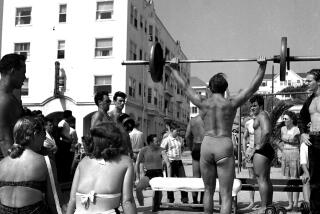Does Breathing Method Affect Workout?
- Share via
Well, it’s that time again--time to reach into the mail bag and answer some of your questions.
* From Mona Baumgartel of Encinitas: “I’ve heard that during weight training, I’m supposed to breathe in through my nose and out through my mouth. But my yoga instructor tells me to breathe in and out through my nose. Does it make a difference if I breathe through my mouth or my nose during exercise?”
Let me begin by pointing out the obvious--that the harder we exercise, the more oxygen our bodies need. When you compare the volume of oxygen that can pass through your mouth with the amount that can pass through two small nostrils, you see why some activities demand mouth breathing--or why football players, who protect their teeth with mouth guards, often wear those nose strips that are supposed to increase their noses’ breathing capacity.
In daily life, we’re supposed to breathe through our noses as a way of filtering, moistening and warming the air before it reaches our lungs. But for me, the only rule that works for exercising is to breathe however I’m most comfortable. While doing yoga, I breathe through my nose. While lifting weights, I inhale and exhale through my nose, but with heavier weights, I breathe more through my mouth. And while doing heavy aerobic activities, I usually do a combination of nose-mouth breathing. As long as you remember to breathe at all (some people tend to hold their breath during exercise), don’t worry too much about how you do it or how the oxygen reaches you.
* From Carole A. Groux of Phoenix: “Is it true that drinking diet soda affects my body’s ability to absorb calcium?”
In a word, possibly. Diet soda contains phosphates and coloring agents that may interfere with calcium absorption, says the National Osteoporosis Foundation. Making matters worse, most colas and some other soft drinks are laden with caffeine, which hastens calcium loss because it’s a diuretic; out goes the calcium in your urine. Since women older than 25 need at least 800 milligrams of calcium daily, my suggestion is to limit caffeine in your daily diet, something along the lines of a single soda and up to two cups of leaded coffee a day.
* From Michael Peretzian of Los Angeles: “Where should my heart rate be for optimum training?”
By “optimum training,” I assume you mean using the time you exercise to the best advantage--that is, to burn fat and achieve fitness as quickly as possible.
You start by determining your maximum heart rate, which means exactly what it sounds like--the fastest your heart can beat. To find it, subtract your age in years from 220; if you’ve been training regularly, however, subtract half your age from 210, which yields a slightly higher number.
Once you’ve identified your maximum heart rate, determine your target zone--a range between 60% and 85% of maximum. Below 60%, you’re just kind of dogging it. That doesn’t do your body as much good, because you’re not pushing it hard enough to make a real difference in your fat level or your fitness level. Above 85%, you’re pushing your body past its ability to deliver oxygen to the tissues. These anaerobic workouts can provide benefits when done in short “bursts”; however, when overused, they can also cause injury or burnout, neither of which serves you well.
To make sure you’re working within your target zone, use a heart rate monitor, or go the low-tech way by rating your own perceived exertion on a 1 to 10 scale, with 4 to 5 being easy (60% to 70% of your maximum); 6 to 7, moderate (70% to 80% of maximum); and 8 to 9, hard (80% to 85% of maximum). For “optimum” training, what works best is to divide your workouts between aerobic and anaerobic, because training at different intensities forces the body to adapt and improve its fitness level. Do the same number of moderate workouts as easy and hard put together. So if you work out four times a week, do one easy, one hard, and two moderates. That allows you to push yourself, recover, set a new standard and heal. It also makes for a lot less boredom, which is ultimately the killer of any exercise program.
Thanks again for writing in. I always look forward to reading, and answering, your questions.
*
Copyright 1999 by Kathy Smith
Kathy Smith’s fitness column appears weekly in Health. Reader questions are welcome and can be sent to Kathy Smith, Health, Los Angeles Times, Times Mirror Square, Los Angeles, CA 90053. If your question is selected, you will receive a free copy of her new video, “Kickboxing Workout.” Please include your name, address and a daytime phone number with your question.
